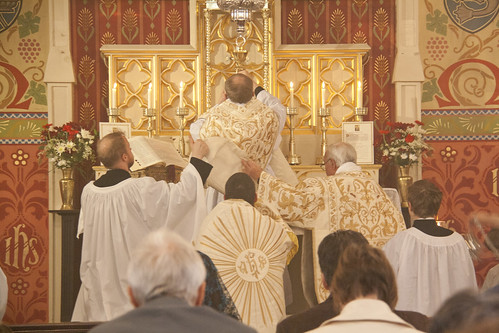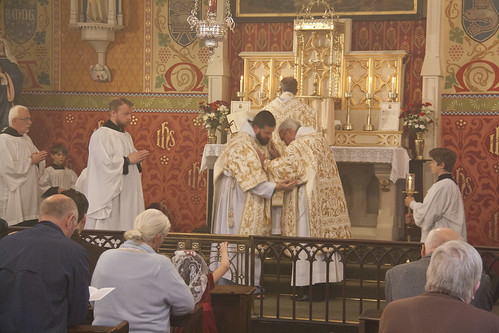 |
| Dull would he be of soul who could pass by / A sight so touching in its majesty. (Wordsworth) |
The Novus Ordo Missae, and the attitudes which led to it, has created a problem in relation to children, because the leading idea of the reform was that worshippers should be able to understand the liturgy at a verbal level. That is the point of putting it into the vernacular, or having shorter and theologically simpler prayers, of getting the people to make more responses, and so on. Why is this a problem for children, you ask? Doesn't all this make it easier for children to understand? At a verbal level, the OF is indeed easier for children to understand. The problem is that if your conception of participation is verbal comprehension, then you have set yourself an impossible task in getting children, particularly small children, to participate. It doesn't matter how simple the language is. Some of the children at Mass can't even talk.
To repeat, the Ordinary Form is vastly, incomparably, better suited to immediate verbal comprehension than the Extraordinary Form. Not only does the latter use a non-cradle language, Latin, but even a worshipper who was a Latin prodigy would not be able to grasp the Canon or the Offertory at a verbal level as it goes along (without looking at a book) because they are said silently. This fact makes it obvious that immediate verbal comprehension is not the aim of the EF. Instead, it uses a range of verbal and non-verbal means to communicate something deeper than mere words, and does so with great effectiveness, just as the liturgy of the Eastern Churches does. The problem created by the OF is that, having set immediate verbal communication at the objective, and having removed the great bulk of the things which facilitate non-verbal communication in the EF, it is then faced with a category of worshippers with extremely limited, or indeed non-existent, verbal skills. Small children are never going to participate in the Mass in the way that the creators of the Novus Ordo wanted people to participate: with immediate verbal comprehension.
The response of the promoters of the liturgical reform was twofold. First, they tried to make the language even easier: having set out to create a Eucharistic Prayer which is 'short and very simple in its ideas', viz. EP2, they realised this was still far too difficult for children, so they created special Eucharistic Prayers for them. Other adaptations to the liturgy when offered for children are also recommended in the Directory for Children. The result of course can be a liturgy quite unbearable for adults, but in any case small children will, still, hardly understand a word of what is going on.
The Directory for Children is very concerned about children bing bored. So the second prong the response is to take children out of the liturgy altogether, at least for a large chunk of the Mass, and to give them some kind of para-liturgical experience instead. Many of these are hideous in every way; no doubt others are well-constructed and reverent. But they don't and can't solve the problem, because although there is even more flexibility about the language used, verbal comprehension is always going to be difficult or indeed impossible with children with little or no verbal capacities. At the same time, the informality of these para-liturgies moves us even further away from the techniques of non-verbal communication which work so well in the EF.
In other words, the means adopted to make the liturgy easier to understand by children are digging us deeper and deeper into the hole. Adopting simpler and simpler language in a more and more informal structure, makes it harder and harder for the children--or for anyone--to pick up non-verbally the sacred realities taking place in the liturgy. But with children, particularly small children, such non-verbal cues are the only way of engaging them, because they have limited or actually no ability to use words.
 |
| You have to be highly educated to think that this is not an eloquent symbol. |
Let me make the same point from another perspective. In the EF, there is great formality in what is going on in the sanctuary, and considerable informality about what is going on in the nave. There are no binding rules for the laity to stand and sit and kneel. There are few responses, and there is no pressure to make them. People are free to say their own prayers.
In the Novus Ordo, the situation is reversed. The solemn formality of the sanctuary has been considerably downplayed, and many priests do their best to make things look spontaneous even when they are not. In the nave, it is another matter. The laity can even be barked at to stand, sit, kneel, make responses, hold hands, sing songs, and so on. Their outward liturgical participation is controlled: spontaneity is forbidden.
What of children in the two settings? In the first, they can move around with less chance of disturbing others, because there is no elaborately choreographed activity going on among the congregation. On the other hand, the stuff going on the sanctuary is deeply interesting from a visual point of view, and will become embedded in their imaginations precisely because it is predictable and repeated. Furthermore, it creates a powerful atmosphere of quiet and awe, which children are well adapted to absorb.
In the second, there is pressure to take part, if not in the main congregation's activities, then in special activities for the kiddies in the Children's Liturgy. Children are systematically prevented from thinking their own thoughts, or absorbing what is going on at their own pace, in their own way. Then again, there is much less to see, and what there is does not fall into such well-defined patterns; it is less dramatic, less vivid, and isn't repeated week by week in the same way. The sense of the sacred, the 'sacrality', everyone seems to agree, is less pronounced.
Which is better suited to the participation of children? I think the answer is obvious.
To summarise the matter, the kind of participation proposed to the laity in the Ordinary Form is less suited to children.
This is a particular application of a more general point, which I have made before on this blog. It is commonly observed that the less educated, and men, are less readily engaged with words, and this is part of why, as Anthony Archer argued, the Catholic Church lost its English working-class backbone after 1970; it is also part of why Novus Ordo congregations are skewed towards women, and EF congregations are more balanced between the sexes. The problem arises even more acutely with groups of Catholics for whom the vernacular used in the liturgy is not their mother tongue.
The Novus Ordo was composed by, and for, highly articulate, intellectual, educated, middle class individuals, who managed to persuade themselves that what they were doing was going to be quite marvellous for the simple folk, the missions (where vernacular Masses are frequently not in the language of the people present), and for children, because it was all going to to be simple.
Simple things for simple people. Well these 'simple people' may even have been better equipped than the patronising middle class educational elite to pick up the symbolic and atmospheric cues of the ancient liturgy: the anthropologist Mary Douglas argues this in all seriousness. What they are not so good at is this precisely this verbal stuff.
 |
| Photos: High Mass in Holy Trinity, Hethe. |
Not only was the Novus Ordo composed by and for an articulate, educated middle class it was also composed at a time when verbal and written communication was the norm. The digital age has seen a huge return to visual communication which the Church, in downplaying or sidelining gesture, vesture and symbolic acts, has largely lost. The "modern" is now old hat!
ReplyDeleteYour two posts rang very loud bells with me; I have shared this one on Facebook and so far received comments from a fellow-Orthodox ("My unchurched niece (then four) once pointed to the Royal Doors and whispered to me, 'This is the Kingdom'. Children are not too young for liturgy. Adults are too old") and an Anglican ("if worship is conducted in the manner of a primary school class, those who feel they are a bit too old for such things (especially men) may feel that they would rather worship under the Blue Dome of Heaven"). I would add these observations: (1) Experience of worship needs to be reinforced by teaching. Not every family is able to provide this, and schools, even "church" ones (as you rightly point out elsewhere), sometimes propagate some pretty odd stuff. For many years I was an Anglican, on the Catholic wing of the church. In some places the liturgy could be quite as enthralling as under the Roman obedience (if not more so: see below), although sermons tended to be longer and perhaps more cerebral. I have memories of one such church where after the Gospel the children were invited to withdraw to the choir vestry with the Vicar's wife and other sympathetic ladies and engage in (presumably instructive) activities; they returned during the Offertory hymn, I think, having missed the sermon, Creed and prayers of intercession. I suppose the idea of the "children's liturgy" grew out of practices like this. (2) Churches where the Old Mass has been revived are likely to do it well, with good music and carefully choreographed ceremonial, especially if they're in places like Oxford or London or under the care of liturgically-minded religious orders. I'm old enough to remember the grim reality of how things were in your average Catholic parish, with Masses rushed through in indecent haste, and significant advantage taken of the fact that the Sunday obligation could be satisfied by arriving in time for the Gospel and leaving when the priest had made his Communion.
ReplyDeleteHow things were in your average Catholic parish in the old days, of course (before V2).
ReplyDelete